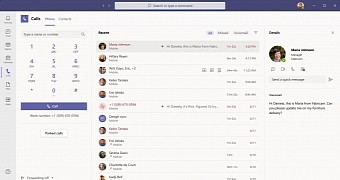The adoption of Microsoft Teams has skyrocketed this year for obvious reasons, and Microsoft claims it now has over 100 million active users, something the company didn’t expect to happen in such a short time.
But people forced to work from home during these wild times pushed more companies to Microsoft Teams, and Microsoft has thus been forced to accelerate its efforts on improving this service in a way that better meets customers’ expectations.
The company has announced a massive update for Microsoft Teams, and it all starts with an improved calling experience, with a new dedicated screen now providing you with everything you need to call a contact, including a dial pad, the call history, voicemail, contacts, settings and so much more.
Then, Microsoft now allows users to save call recordings in OneDrive and SharePoint, something that customers have been asking on several occasions.
“Call recordings are a great way to keep track of the ad hoc brainstorming that often happens on a call. Now, Teams Admins can take advantage of the tight Teams and OneDrive or SharePoint integration and elect to make OneDrive or SharePoint the default recording storage location, in lieu of Stream. This new capability provides powerful capabilities such as sharing with external guests, quicker access to transcripts, and greater storage capacity,” Microsoft says.
In addition, there are new call capabilities, including spam identification, call merge, low-data mode, and enhanced reverse number look-up.
One particular feature is transferring calls between the mobile and the desktop, something that you’re going to love if you’re always on the go. What this feature does is allow you to transfer an active call from a PC to a smartphone (Android or iPhone), so you never interrupt a meeting.
“Teams makes it easy to place and receive calls from several different endpoints, including desktop and mobile devices, but sometimes you need to move locations or devices to finish your call. Starting in early 2021, you will be able to shift your calls between your mobile and desktop endpoints with an easy-to-use interface on the Teams app,” Microsoft says.
Businesses are also provided with extra capabilities, such as resilient calling, call transfer ring-back, voice enabled channels, and Certified Contact Center solutions.
Microsoft has also announced support for low-cost phones in Microsoft Teams, and this should go live as soon as the next year.
“To empower organizations to bring the best of Teams Calling to as many users as possible, we’re excited to bring low-cost phones to market with trusted partners Yealink and AudioCodes in early 2021. These devices integrate natively with the Teams phone app, bringing core Teams capabilities to life,” the company says.
Of course, Microsoft Teams is also expanding beyond the classic desktop, and one way to do this is to bring the service to platforms that integrate Cortana.
As you probably know already, Cortana has become a second-class citizen in Windows 10, but the reason isn’t that Microsoft wants to give up on this application, but the company’s desire to focus more on its enterprise capabilities. So now that Microsoft Teams will play even nicer with Cortana-powered devices, everything makes a lot more sense.
“Whether you are working remotely or returning to the office, adding an intelligent companion device like the Teams display can revolutionize the way you work. A new experience now available on the Lenovo Thinksmart view, Teams displays integrate Cortana for hands-free productivity, use AI to help you stay productive and organized, and provide a dedicated device for your Teams collaboration needs,” Microsoft concludes.

 14 DAY TRIAL //
14 DAY TRIAL //